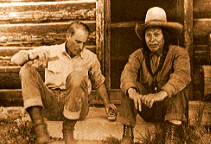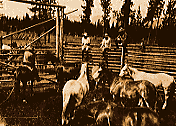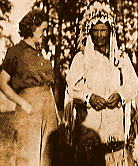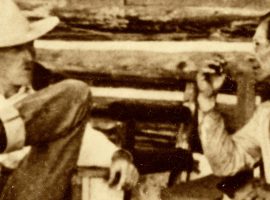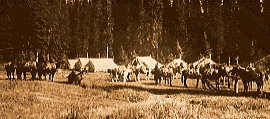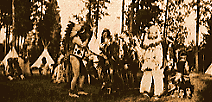In the late 1920’s, Jan Boissevain and Colonel George F. Weisel purchased a stock ranch in Western Montana known as the Corbett Ranch. Boissevain, an avid horseman, dreamed of turning this property into a dude ranch, which he would name after the brand on his favorite horse.
His dream became reality in 1929, when the “Double Arrow Ranch” was established as the first commercial dude ranch to be located at Seeley Lake.
The Double Arrow Ranch
By Mildred Chaffin–1989
The Corlett Ranch was a stock ranch before it was bought in the late 1920s by Jan Boissevain and Colonel George F. Weisel. Boissevain dreamed of building it into a combination horse and dude ranch. The Double Arrow Ranch, named after a brand on Boissevain’s favorite horse, was established in 1929 and became the first commercial dude ranch to be located at Seeley Lake.
Boissevain was a competent horseman and had even served as a reserve officer in the Dutch Cavalry. There he had ridden an American horse with a double-edged spear brand and the animal, he found upon investigation, had come from the Spear Brothers Ranch at Drummond, Montana. The young officer later left the Cavalry to go into his family’s banking business and found himself transferred from Amsterdam to Texas, then to Spokane, Washington, where he met Allen Toole, son of John H. Toole, president of the Anaconda Company’s Timber Division at Bonner.
Boissevain was not favorably impressed with Montana until he accepted an invitation to visit at Toole’s summer cabin at Seeley Lake. There, he met Toole’s brother-in-law, George F. Weisel, and they began to talk of starting a dude ranch. They learned that Frank Scully and a man by the name of Nesbitt had planned to establish a dude ranch. However, Boissevain and Weisel bought the property and re-named it The Double Arrow because of the brand on Boissevain’s favorite horse.
Building the Ranch
It took about a year to transform the Corlett Ranch into the Double Arrow “dude ranch.” Three log “Scully” cabins were moved from the Trail Creek area and located at the Double Arrow building site. After a winter of hard work several of the present ranch buildings were finished. Some of the people who worked on the construction were Earl Wood, Cliff Vaughn, Vic Parent, Irvine Sperry, A. Mcdonald, Bill Stewart, and W. Christenson. Carpenter Fred English and his crew from Missoula put in tamarack (or larch) flooring and did the finishing work. Dave Thompson was the “skinner” (horse driver) and Emil Gobalet was the stone mason. Col. George Weisel closely supervised all the construction in 1929 and 1930.
Sometime during the construction period, Boissevain made a trip East to drum up some opening trade. On July 1, 1930, the president of Cornell University and his wife arrived with other notables as guests.
The Double Arrow Ranch began raising fine horses, too. Boissevain brought the first thoroughbred stallion to the ranch in the fall of 1930. That horse was obtained from a re-mount service in Colorado. The stallion had been injured during training for races, but he had a gentle disposition and sired many fine colts. Boissevain and Weisel bought other horses from the Flathead Indian Reservation and from the Bitterroot Valley. The ranch did not produce enough hay to keep the entire herd of horses over the winter. Most of them were driven over the Jocko Trail to winter in pastures in the Mission Valley – a custom practiced by most of the dude outfits at the time.
Some Tough Years
By now, Boissevain, divorced from his first wife, had become engaged to his partner’s daughter, Anna Afton Weisel. The wedding took place after that first guest season was attended by people from all over the United States and part of Europe. After a honeymoon in Hawaii, the young couple returned to build a cabin for themselves which is still called the Hilltop House.
Tragedy struck. In the spring, Anna died in childbirth. Boissevain had completed the house, the dude season was about to begin, and he was forced to carry on.
By 1932, the Great Depression had caught up with the recreation business and the Double Arrow was struggling to stay afloat. Weisel sold his interests to Boissevain in 1932 in order to start over with the Circle W dude ranch on the Blackfoot River.
Boissevain married Edith Greenough of Missoula in 1933. Together they tried to keep the business in operation, since they were still getting a few guests. At this time, they also started breeding horses which were sold to the Army.
Indian Camp
In the fall, the Indians came over the Jocko Pass to camp and hunt on Double Arrow land. Boissevain felt that they had a right to use the land as they always had and he welcomed them. Eneas Granjo and his family, John and Agnes Pelko, Mischelle Kiser, Happy Ninepipes and Mose and Ellen Big Sam were among them. He even rode to warn them when the game warden was on the way!
Being unaccustomed to his strange manner and his accent, the Indians didn’t care for him at first, but later grew to like him a lot. They never learned to pronounce his name but there was a big dinner bell that he rang and they nicknamed him “the Bell Boss.” Mose Big Sam even built a sweat house for The Bell Boss right outside the front porch at the Hilltop House. In summer they often put on their ceremonial costumes and danced for the guests.
Depression Years
During Depression days, Missoula County contracted with the Double Arrow to house about one hundred unemployed lumberjacks, supplying double bunks from a nearby logging camp and setting them up in the guest cabins. The ranch kitchen, which had been equipped to serve royalty, now served these men who found themselves out of work.
By 1938 Boissevain had tried just about everything to ward off hard times. He even tried starting a ski resort. Bob Manchester, a college student and skier, helped him clear the hillside behind the ranch buildings and the two men lay on the ground with crosscut saws to cut the stumps low enough to ski over.
The ranch provided work for a number of local people throughout the Depression years. Lester Perro was head packer and Herb Townsend was horse breaker and jack-of-all-trades. Herb remember a black lady who was “a mighty good hand in the kitchen.” But the woman looked out the window one day just in time to see a mountain lion making his way across the yard. Now, this wasn’t in her contract at all. They had to take her back to Missoula the next day and the Double Arrow was in the market for a new cook.
There were the usual pack and travel troubles. Les Perro had reason to remember some of them. Having tied his “string” together for one certain trip, he mounted his saddle horse and picked up the lead rope to line them out.
“We were in the open field below the lodge,” Herb Townsend said. The horse in the middle of the eight-horse string was carrying the kitchen consisting of a camp stove, pots and pans, tin plates, knives, forks, and such, a rolled up canvas tabletop and a few cans of food. The pans and silverware started to rattle and the horse spooked and broke loose from the one she was tied to. Taking the three that were trailing her, she went to bucking and kicking to rid herself of the load on her back. The three others broke loose and took off with their packs. The kitchen packs came loose and the contents began to fly.
“We never did find all that gear,” Herb said. “But C.B. Rich found silverware from the episode when he came to the ranch some twenty years later.”
The beginning of World War II in 1941 delivered the final blow to Jan Boissevain and the “dude ranch” at the Double Arrow. He offered his services to the United States Armed Forces but was not accepted because of his age and his failing eyesight. In 1942 he auctioned off the ranch and the business and moved to California. It is said that when he returned to Seeley Lake for a visit in later years, he expressed pleasure at seeing that the hay meadows were green and that the place had again become a working ranch.
History of Ownership
In the 1940s and early 1950s, the Double Arrow Ranch saw several owners and operators. Among them were Ray Cory and Whitey Rahn, Hollywood film makers.
C.B. and Helen Rich purchased the Double Arrow in the fall of 1958 from Jack Lanham, Missoula. Bob Bandy had leased the ranch from Lanham at that time. He had run a small bunch of Hereford cows and milk cows. His wife, Mary-Dell, had also raised some grade and purebred Arabian horses.
C.B. Rich had been an outfitter and packer in eastern Montana for many years. When Yellowstone Park managers killed off thousands of elk near the Slough Creek drainage where C.B.’s main camp had been, C.B. was forced to look elsewhere for a packing/outfitting headquarters. Bob Cooney, then head of the Fish, Wildlife and Parks Department for the state, suggested that C.B. look at the area on the southwestern edge of the Bob Marshall. The area’s elk population were stable, thanks to the newly developing Blackfoot-Clearwater Game Range.
A Dude Ranch, or Cattle Ranch?
C.B. Rich shared some stories about the early days at the ranch. “The dude buildings had been allowed to run down, and we thought we budgeted enough to repair them. We didn’t however, and maintenance and repair of the buildings were the problems we faced as long as we owned the property.” C.B. and Helen outfitted dudes that first season in the Bob Marshall Wilderness. They returned to their work of fence repair and building maintenance that winter. The Rich family was in for more surprises at Seeley Lake.
“To heat the lodge took a lot of wood. I had figured on being able to skid it out and haul it with horses the way we had in eastern Montana. We had four to five feet of snow that second winter, and we worked the horses pretty hard to get out a bare minimum!” C.B. said.
C.B. and Helen brought their Hereford cattle to the Double Arrow during their first winter at Seeley Lake. “We hauled the cattle in early February. We went down and gathered them from wind-blown winter pastures in eastern Montana. Helen had asked Bob Bandy to plow out a food grounds at the Double Arrow. I still thank him for that. I doubt that we would have ever gotten those cattle off of the trucks. There was some four feet of snow and not a dry place to lie down anywhere. Those poor old cows walked and bawled for a week.”
The Rich’s learned the hard way that the Double Arrow wasn’t the most productive place to raise cows. Calf weights at sale time averaged 500 pounds in eastern Montana. At Seeley Lake, the average calf weights went down to as low as 378 pounds. Besides that, they lost some cows that had developed asthma. “That was unheard of in eastern Montana,” Rich said.
“With that,” C.B. explained, “we decided that this wasn’t good cattle country, or that possible our eastern Montana cows would never make the transition to it, so we sold them.”
In 1966, after coming up $100 short on a ranch payment, C.B. and Helen attempted to refinance their contract. They were unsuccessful. They sold the ranch to John Parker and Harold Mildenberger from Hamilton. The Rich family kept the pack outfit and leased the ranch back from the new owners. “By that time, I believe every roof on the place was leaking, some of the foundations sadly needed repair, and it was easy to see that we had gotten behind in our maintenance and repair,” C.B. said. Mildenberger and Parker spent some $20,000 doing the basics such as reroofing, C.B. explained. Later in 1966, the ranch was again offered for sale. A Mrs. Snyder of Great Falls held an option on the ranch for a couple of months. Finally, it was sold to a man by the name of Lee Dahl. C.B. and Helen still kept the pack outfit and continued to operate as Double Arrow Outfitters. During the years that Dahl owned the ranch, an auction was held. All of the equipment and furniture was sold. In previous transactions, all of the original equipment and furniture had stayed with the ranch.
At this time, C.B. and Helen terminated their lease with the Ranch. The current owners owed them money, and the Rich’s took some of it in rent for Hilltop House, along with pasture and horse feed. In 1970, Mr. Dahl left the ranch. Art Borstad of Minnesota, who had financial interest in the property at that time, asked C.B. and Helen to help with repair and maintenance of the ranch buildings. C.B. and Helen kept the pack outfit at the ranch. That same year, the ranch was sold to Herb Richards, president of Life of Montana. He immediately began restoring the buildings. Log buildings were sanded inside and out. The first well was drilled, since the water supply for the buildings had previously come from Drew Creek. The buildings were completely redone, including plumbing, wiring and roofing. Oak ranch furniture from Texas was imported to decorate the Lodge. It was during these years that the subdivision of the ranch began.
“Good or bad, he (Richards) also began subdividing with an area along the Clearwater River, another one on Morrell Creek and a third one in the head of Drew Creek,” C.B. said. This left about 2,000 acres of the ranch intact, with plenty of room for the pack outfit.
In 1977, John Trippe put together a limited partnership and purchased the ranch. They finished restoration of the buildings and added a swimming pool, tennis court, and two buildings with four condominiums each. They also added a hot tub building and hot tub. In the horse facilities, they added a 20-stall pole barn with a tack room and an arena. That year they bought the pack outfit from C.B. and Helen Rich. For a short time, the pack outfit was once again under the ownership of the ranch. However, Jack Rich, C.B. and Helen’s son, soon bought the pack outfit back from the ranch’s owners. Jack Rich has operated Double Arrow Outfitters since that time.
Recent History of the Brand
In 1958, Jack Lanham had the Double Arrow brand registered on the left jaw on horses, and on the left shoulder on cattle. C.B. disliked both locations. “Every horse I ever saw with a jaw brand was head shy. Branding cattle on a shoulder is very difficult with a one stamp iron, since you have a hard time rolling it over the shoulder blade and getting a complete brand. As a result, I went to the office of the Recorder of Marks and Brands in Helena and spent the better part of two days tracing out the Double Arrow. I finally found that it could be recorded on the left thigh on horses and the left ribs on cattle, so I had it done.”
In later years, when it became apparent that the Rich family would continue to operate Double Arrow Outfitters separate from the ranch, C.B. registered the Double Arrow brand as a logo and trade name. He also registered the brand on the left neck as well as the left jaw.
When Jack Rich purchased the outfitting business back from John Trippe, C.B. deeded the brand on the left thigh on horses and the left ribs on cattle to Jack. C.B. kept the brand on the left jaw or the left neck on horses, and the left shoulder on cattle. C.B. still owns the Double Arrow brand as a trademark and form of display. “I will also deed that to Jack,” he explained.
Conclusion
In 1989 C.B. and Helen Rich summed up their feelings about the Double Arrow Ranch. “I think that all of us were taken with the romance of the old buildings, the mountain setting, the history of Jan and so on. I know that was the case with all of our family. We were especially caught up in the dream after talking with Jan and his son Dutch for ten or fifteen nights when they vacationed here. However, the facts still remain. There has been something over a half million dollars spent in trying to save the buildings.” The subdivision of the ranch in the seventies and eighties was a controversial subject in the Seeley Lake community. It seems, however that through the years the investors had no choice except to finance the refurbishing of the original ranch through the sale of smaller parcels of land. Today, the ranch consists of the old lodge, cabins and the horse facilities on about 200 acres.
Recent History Addendum
In 1989 the Lodge once again changed ownership. A group of six couples from the Seattle area, all with Montana roots, purchased the Lodge.
The historic Double Arrow Lodge has undergone significant improvements, while keeping intact its highly valued charm and cozy ambiance. All original cabins have been remodeled and upgraded. New lodging units were added in 1993, 1996 and 1997. A challenging golf course opened in 1994.
Providing a quality dining experience has been a commitment of the current owners. Every dish is a culinary treat for the palate and eye, skillfully prepared from the freshest ingredients by our exceptional chef.
In 1997, the historic Hilltop Lodge underwent a complete remodel to compliment the newly constructed Blackfoot Conference Center.
A cabin was moved to open up a courtyard lawn area. The Double Arrow Road, which disected the property, was moved to restrict traffic through the resort property.
In 1998, plans began to move the historic Double Arrow Barn to the main highway, where it will become the home of the Seeley Swan Visitor Center. This project is a continuation of the resort’s commitment to being an active part of the community development.
The above is a chapter from the book Cabin Fever, a centennial collection of stories about the Seeley Lake area. Cabin Fever is available locally and all profits benefit the local Historical Society.


